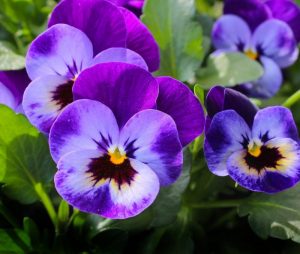Garden pansies belong to the most popular flowers that adorn parks and gardens during cool temperatures. Many people successfully grow them in pots on terraces and balconies. Although taking care of garden pansies does not pose many problems, we recommend learning about their preferences so they will give you the desired results in your landscape plan.

Choosing the right site
A site for the garden pansy has to be a little bit sunny or partially shady. However, they should not grow in the shade, as they would develop long stems and produce distinctly fewer blooms. Garden pansies grow best in humous, permeable, fertile soils, although they would also thrive in the average garden soil, provided you ensure it is adequately watered.
If you have a clay or sandy soil, amend the earth with compost to promote growth of these flowers.
They love cooler temperatures. In fact, here in North Carolina, we plant them in the fall and enjoy them through December.
Planting and propagating garden pansies
You may cultivate garden pansies from seedlings bought in the garden store or produce them on your own. Please note that these are biennial plants. Plants bought in garden stores may be transplanted to the field at the beginning of April already. The majority of garden pansy cultivars are resistant to short-term frosts up to -4°C. These plants do not like heat, though. They should bloom until June but would look at the peak of their charm in May. Garden pansies purchased in the stores are already one year old and will die after their flowers wilt.
If you decide to prepare the seedlings on your own, sow the seeds onto a field or a seedbed end of June or the beginning of July. Seeds should germinate within 1 – 2 weeks. You can find the pansy seeds in this shop. After developing 3 – 4 true leaves, prick them out, leaving 4 – 5 cm distances between the plants. Transfer garden pansies to the permanent site at the end of August or September in 20 cm spacings. Cover them with spruce twigs and needles for the winter. They will bloom abundantly early in spring next year.
Caring for Your Garden Pansies
You need to water garden pansies regularly and loosen the soil around them after transferring them to the field. As soon as they have started to bloom, ensure that the soil is constantly moist yet not water-logged. Garden pansies do not stand dryer soils, even for a shorter time span. Plants exhausted by the lack of water may fall to the aphids. Apart from that, they are fairly sensitive to diseases, so it is imperative not to wet their leaves when watering. You should also conduct this activity in the evenings or mornings.
Also, you will enjoy abundant blooming by providing the garden pansies with the right dose of nutrients. You may strengthen them with diluted standard fertilizer every two weeks. If you, however, provide them with fertile soil straight away, additional supplementation would not be needed. You should also remember to remove wilted inflorescences to prolong the blooming period.
The Takeaway: Enhance the Colors of Your Garden with Pansies
These violet beauties thrive in shady, moist, cool climates. That fact makes them ideal for summertime in shady areas or in northern growing zones. However, those in the south or southwestern states can enjoy them in the autumn, early winter, or spring time. You will enjoy these for their lovely color and mild fragrance. So they are worth your time and effort.


